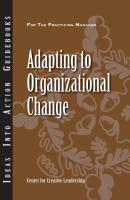Adapting to Organizational Change. David Dinwoodie
Чтение книги онлайн.

Читать онлайн книгу Adapting to Organizational Change - David Dinwoodie страница
Название: Adapting to Organizational Change
Автор: David Dinwoodie
Издательство: Ingram
Жанр: Управление, подбор персонала
isbn: 9781604916621
isbn:
AN IDEAS INTO ACTION GUIDEBOOK
Adapting to Organizational Change
IDEAS INTO ACTION GUIDEBOOKS
Aimed at managers and executives who are concerned with their own and others’ development, each guidebook in this series gives specific advice on how to complete a developmental task or solve a leadership problem.
| CONTRIBUTORS | David Dinwoodie, Edward Marshall, Russ McCallian, Bertrand Sereno, Jim Shields, Sophia Zhao |
| DIRECTOR OF ASSESSMENTS, TOOLS, AND PUBLICATIONS | Sylvester Taylor |
| MANAGER, PUBLICATION DEVELOPMENT | Peter Scisco |
| EDITORS | Stephen RushKaren Lewis |
| ASSOCIATE EDITOR | Shaun Martin |
| COPY EDITOR | Tazmen Hansen |
| WRITER | Martin Wilcox |
| DESIGN AND LAYOUT | Joanne Ferguson |
| COVER DESIGN | Laura J. GibsonChris Wilson, 29 & Company |
| RIGHTS AND PERMISSIONS | Kelly Lombardino |
Copyright © 2013 Center for Creative Leadership.
All Rights Reserved. No part of this publication may be reproduced, stored in a retrieval system, or transmitted, in any form or by any means, electronic, mechanical, photocopying, recording, or otherwise, without the prior written permission of the publisher. Printed in the United States of America.
CCL No. 457
ISBN No. 978-1-60491-160-2
CENTER FOR CREATIVE LEADERSHIP
AN IDEAS INTO ACTION GUIDEBOOK
Adapting to Organizational Change
THE IDEAS INTO ACTION GUIDEBOOK SERIES
This series of guidebooks draws on the practical knowledge that the Center for Creative Leadership (CCL) has generated since its inception in 1970. The purpose of the series is to provide leaders with specific advice on how to complete a developmental task or solve a leadership challenge. In doing that, the series carries out CCL’s mission to advance the understanding, practice, and development of leadership for the benefit of society worldwide.
CCL’s unique position as a research and education organization supports a community of accomplished scholars and educators in a community of shared knowledge. CCL’s knowledge community holds certain principles in common, and its members work together to understand and generate practical responses to the ever-changing circumstances of leadership and organizational challenges.
In its interactions with a richly varied client population, in its research into the effect of leadership on organizational performance and sustainability, and in its deep insight into the workings of organizations, CCL creates new, sound ideas that leaders all over the world put into action every day. We believe you will find the Ideas Into Action Guidebooks an important addition to your leadership toolkit.
Table of Contents
IN BRIEF
Change is a constant in today’s workplace, and leaders must learn strategies to deal with change successfully, or otherwise face derailment. To succeed, you must first understand how changes within your organization are affecting you, and then use that understanding to help manage the transition from the old way to the new way of doing things. This transition typically occurs in three distinct phases: the ending, where you accept the conclusion of the old way of doing things; the neutral zone, where you begin to adapt to the confusion of the new way of doing things; and the new beginning, where you accept the new way of doing things and begin to successfully move forward in the new environment. Furthermore, by understanding how you and other individuals perceive your organization, you can gain a greater awareness of how to specifically manage the transition. Once you have done this, you will be able to move forward, helping yourself and the individuals you lead to survive and thrive.
Change and Transition
Today there seems to be very little business as usual. Turbulence is common, with organizations facing a dizzying array of changes. Many of these are small, but a significant number affect the entire organization. An organization’s mission may change, as well as its focus, strategy, culture, and market. Such changes can have a serious impact on you as a leader.
Your success as a leader will very likely depend on how well you deal with such change. Research by the Center for Creative Leadership has found that successful executives adapt to the changing external pressures facing the organization, adjust management style to changing situations, accept changes as positive, revise plans as necessary, and take into account people’s concerns during change. In fact, in CCL’s research regarding North American and European leaders, the most frequently mentioned success factor was the ability to adapt. In describing leaders they knew, American leaders mentioned adaptability in 55 percent of the success stories that they shared, and European leaders mentioned adaptability in 67 percent of the success stories that they shared.
CCL research has also found that leaders who aren’t able to adapt to change—those who show a marked resistance to change and an inability to learn from feedback and be flexible—are likely to derail: to stop advancing or СКАЧАТЬ